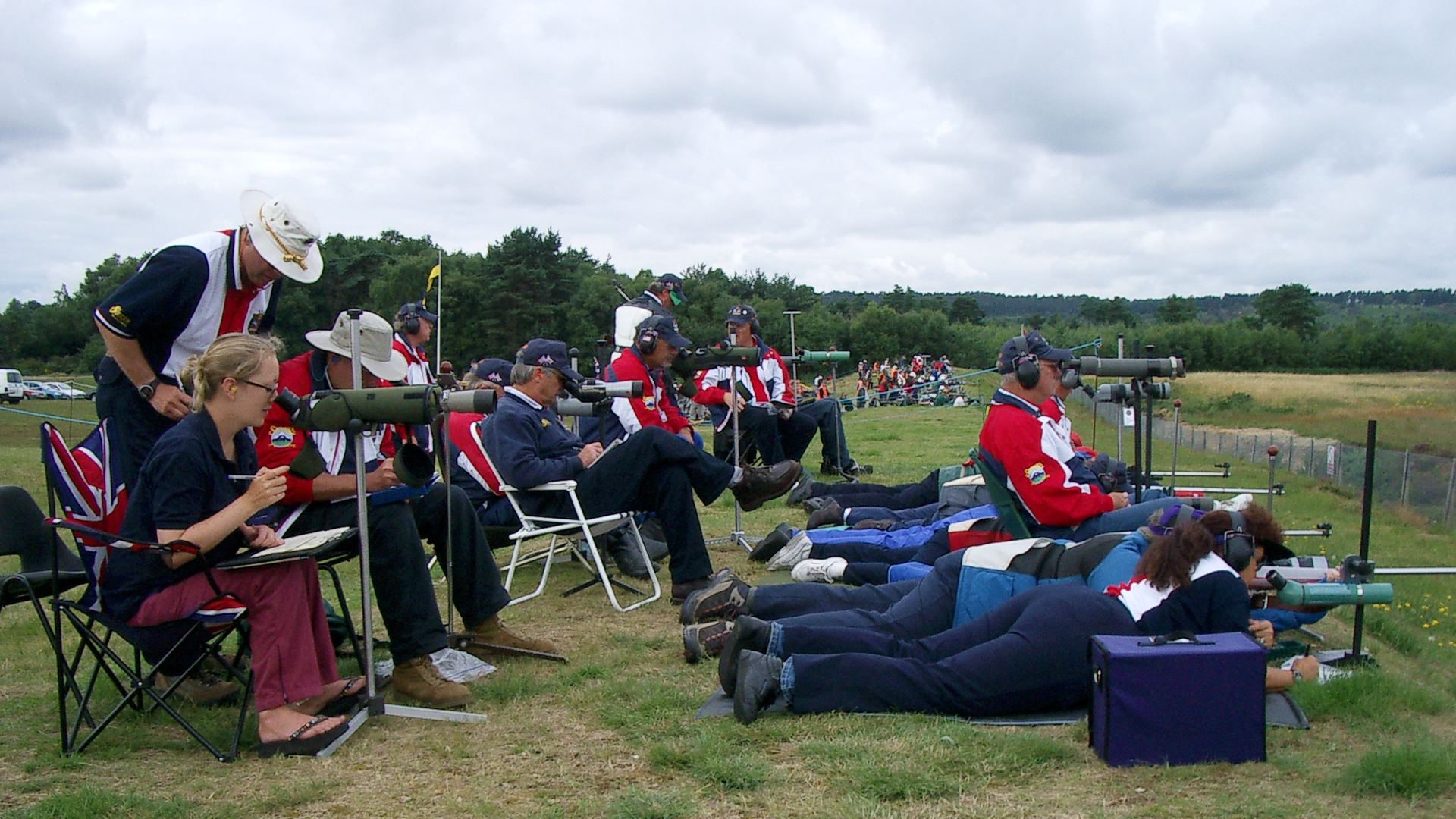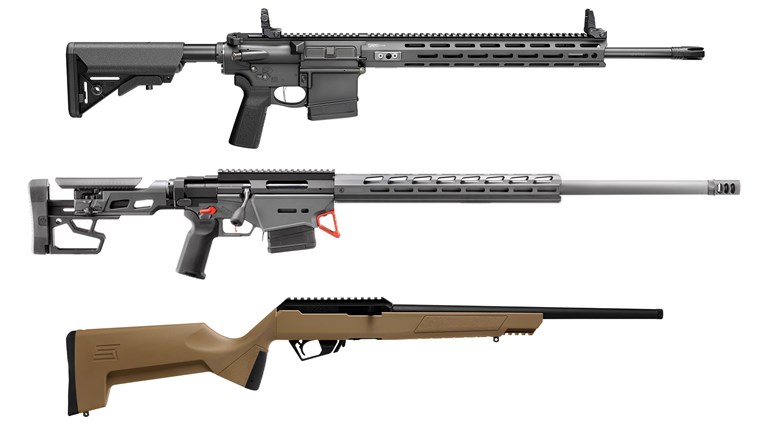
From the vault: Our coverage of the 2003 World Long-Range and Palma Team Championships, held that year at Bisley Range in the United Kingdom. Read below the article by Ron Sekellick as published in the January 2004 issue of Shooting Sports USA.
U.S. Palma Team Wins Silver At Bisley
Story by Ron Sekellick
Photos by Ray Gross
The 2003 United States Palma Team put on a superb performance during the Palma Team Matches in July at Bisley, England, to come away with silver medals behind the gold medal team from Great Britain. Closing the gap of the British team's 110-point lead and an ensuing third-place finish on the first day, the Americans put on a record-setting display of long-range shooting in the second half of the championships, including an extraordinary performance at the final 1,000-yard distance. The final score put Britain on top with a 14121-646X. The Americans secured second with 14056-584X, and South Africa captured third at 14013-563X.
The United States team's record on the second day of shooting was one for the highest one-day team score with its 7132-314X.
Going into the match on their home turf, Britain was highly favored. The team certainly lived up to expectations by opening up an insurmountable lead on the first day, despite horrid shooting conditions. That lead would shift the primary interest to the competition for second place, as silver was to be hotly contested between the USA, South Africa, Canada and Australia.

The United States' team began preparations for the 2003 World Long Range and Palma Team Championships in the fall of 2001 with a team selection process that tested more than 100 candidates during one week of 1,000-yard shooting. From that tryout, the team of 16 shooters, plus alternates, was chosen. A separate coach's tryout was conducted to fill four positions. Team training events were carried out at various locations from the spring of 2002 right up to match time in order to prepare for the main event. Team training consisted of shooter and coach familiarization, process development and the evaluation of various shooting strategies for optimum performance. Going to Bisley, team members felt very confident they had prepared well and would be in a good position to win, depending on weather conditions.
Prior to the Palma Team Match the team members shot in the 134th Imperial Meeting Matches—the English equivalent to Camp Perry's High Power—and the World Long-Range Individual Matches. The Imperial Matches were shot with issued ammo; the World Long-Range Individual Matches allowed the use of handloaded ammo, as did the Palma Team Match. This was a departure from previous Palma Team Matches, where ammo was issued by the host country. The 2003 matches would ensure each team could shoot the best ammo and equipment available.
The USA team members shot well in the Imperial and World championships. Eighteen of the American team made the top 100 in the world out of a total entry slate of 454 competitors. Medals were taken by Nancy Tompkins-Gallagher, gold at 1,000 yards; Sherri Gallagher, gold at 800 yards, the Day 3 aggregate and the overall championships as well as a silver at 900 yards; Gary Rasmussen, bronze at 1,000 yards; Tom Whitaker, silver in the aggregate; Ron Sekellick, bronze at 800 yards and silver for the 900 yard aggregate; Emil Praslick, III, silver at 900 yards; and Mike Dunia, gold at 1,000 yards. The World Individual Championship went to 19-year-old Sherri Gallagher, a member of the USA Under 21 Team. Many of the team members placed highly during the Imperial Meeting Matches and took several awards. Praslick placed fifth in the grand aggregate.

Bisley weather is famous for its wind and rain. This year, the added element was heat. Every competitive shooter knows weather—and the ability to cope with it—can greatly affect the outcome.
The first few days of the Imperial Meeting Matches were hot with mild winds. Weather was ideal for shooting with light- to no-wind conditions in the morning, increasing as the days wore on. Shooter squadding was such that everyone had a chance to shoot at various times of day on various range positions in order to better equalize favorable or unfavorable conditions. A few days of rain near the end of the Imperial Meeting Matches would cool things off and prepare the shooters for good weather when the World Long-Range Individual Matches began. The winds, however, would be a major factor to deal with.
Most of the Imperial Matches were shot on the shorter, 300- to 600-yard Century Range. The 900-yard matches were shot on the longer Stickeldown Range. The World Long-Range Individual Matches are shot on Stickeldown at 800, 900 and 1,000 yards, using the same course-of-fire as the Palma Team Match. The competitors and coaches would have ample opportunity to sample range conditions in preparation for the team matches.
The Stickeldown Range is somewhat unique from most ranges in that the terrain slopes uphill from left to right. The 1,000-yard and longer firing lines are terraced to provide a level line on the high end of the 50-point firing line. The wind conditions along the firing line can be different depending on what direction the wind is coming from. Local knowledge of what the wind does and how to read the wind flags would favor the British team.
The participating teams for the 2003 Palma Team Matches were: Australia, Canada, Channel Islands, Continental Palma Council (Europe), Germany, Great Britain, Kenya, South Africa, United States and the West Indies. Each team consisted of 16 firing members, two alternates, four coaches, an armorer, a captain, an adjutant and a head coach, for a total of 26 team members.
The course-of-fire was twice over the Palma course of 15 record shots, plus two convertible sighters at each of 800, 900 and 1,000 yards. After each stage, the teams would move firing points to equalize range conditions.

Convertible sighters allowed the first one or two sighting shots to be used for record, at the discretion of the coaches. This could speed things up under often-changing conditions. Timing of shooters on the line could provide sighting shots at various times to test conditions without sacrificing record shots. Clearly, a proper shooting strategy would greatly affect the outcome. The teams would have four targets to shoot and shooters could be arranged in any order. Normally, there were four shooters per target. There was a total time allotment within which to shoot all shots.
The first day of the Palma Team Match presented the teams with some of the worst weather seen in the entire competitive shooting evolution. The good weather of the World matches gave way to wind and rain and poor visibility at times, especially as the teams moved back to 1,000 yards.
The 800-yard stage required sight adjustments of 1.5 to three minutes left depending on where the team was positioned. The 900-yard stage required two to six minutes left, while the 1,000-yard stage took eight to 20. The rain subsided at 1,000 yards, but the winds increased. These were horrible conditions, and minimizing errors was the order of the day.
By the end of the first day, the points total dropped by each team was:
- Great Britain: 166
- South Africa: 250
- United States: 276
- Canada: 341
- Australia: 355
- Channel Islands: 416
- Germany: 445
- Kenya: 645
- Continental Palma Council: 671
- West Indies: 671
The weather for the second day improved a bit as the front continued to move out. The rain stopped and the wind began to subside.
The USA team lost some ground to the field at the 800-yard line losing 18 points to Britain's eight and Australia's nine. On the 900-yard line, the Americans held their ground, dropping 24 to Britain's 21, South Africa's 23 and Canada's 26. Australia began to lose position, dropping 40 points.
At 1,000 yards, the wind had dropped considerably, and what wind there was came from six o'clock. The USA team drew a high target number, which was generally known to be a disadvantage. The initial windage adjustments by the USA team was one minute left to four minutes right, shifting back and forth. These were conditions with which the USA team was quite familiar. The first shooters came off the line scored in the high 140s and set the stage for subsequent shooters. As each team member completed the stage they were greeted with applause. The team knew it was on a roll when 148s and 149s were being posted to the scoreboard. It turned out the applause was a bit unnerving to the South Africans, who were on adjacent targets. The race was on to secure second place for the USA team if it couldn't beat Britain.
Secure silver, it did. Team United States set a new 1,000-yard team record, dropping just 26 points—an average score of 148.38 per shooter. Canada was next best, dropping 64 points, then Great Britain losing 84 and Australia 85. South Africa dropped 103 but still managed to hold onto third place overall.
This was a great match for the members of the British team, who have shown themselves to be formidable competitors and clearly the team to beat in 2007 in Canada, the site of the upcoming Palma Team Matches. And since the location is easily accessible to the Americans, there will be plenty of practice there. The Canadians will also be formidable on their own range.
The 2003 United States Palma Team
- Captain: Peter LaBerge
- Adjutant: Roger Whitney
- Armorer: Maj. John Hoham*
- Head Coach: Tom Whitaker
- Coaches: Billy Meek, Nancy Tompkins-Gallagher, Bob Jones, Gary Rasmussen
- Reserves: Mid Tompkins, Gy/Sgt. David Karcher*
- Firing members: Dan Simpson*, Bob Gustin, Sandy Pagel*, David Crandall*, Eric Pintard, Noma Mayo, Emil Praslick III*, Johnie Franklin, Bob Mango*, Bob Gamboa, Dennis Flaharty, Ray Gross*, Kent Reeve, Robert Metaxas*, Norm Crawford, Mike Maurer.
*First time on a Palma team.
2003 Palma Team Matches Leaderboard
- Gold: Great Britain—14121-646X
- Silver: United States—14056-584X
- Bronze: South Africa—14013-563X

































